 Most cycle travellers come across the question at some point: How do I cycle into and/or out of the capital city? How do I plan my route without ending up on the city highway? Where are the back roads?
Most cycle travellers come across the question at some point: How do I cycle into and/or out of the capital city? How do I plan my route without ending up on the city highway? Where are the back roads?
Many roads lead into Lisbon, there are cycle paths and big roads and highways and back roads, and your choice will depend on where in the city you’re heading. We don’t pretend having all the answers or knowing all the options. But we cycled into Lisbon three times, and out of it twice. Here we share our routes and what it was like.
Table of Contents
Getting in
From the East: by ferry from Montijo
Coming from Constância, we followed the river Tejo through Almeirim and Salvaterra de Magos, trying our best to avoid the very busy and dangerous main road by zigzagging on the small roads between the tomato fields.
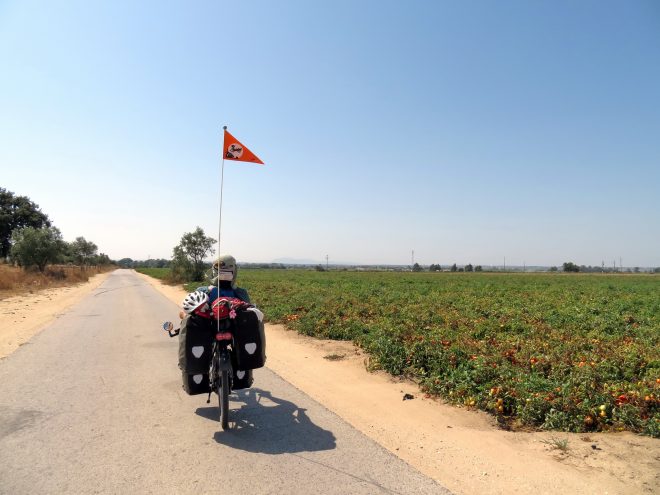
We were headed towards Montijo, and the only way to get there was the very straight and busy N118 – clearly one of the worst roads we’ve cycled in Portugal, but there’s no alternative if you come from that direction, unless you take a huge detour. We left the big road as soon as we could, before Alcochete, and zigzagged again on small roads, passing next to the Salinas and through Samouco, before arriving at the ferry port West of Montijo. Taking the ferry from here to the centre of Lisbon was easy with bikes, but check the timetables in advance as this ferry doesn’t run very often.
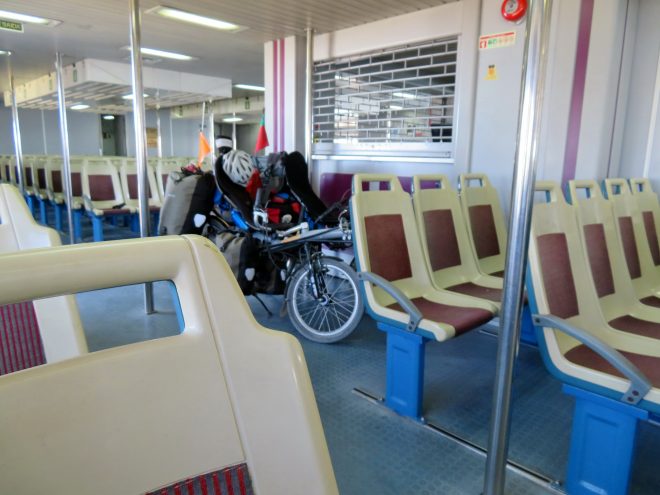
We wanted to join the cycle path starting at the Marquês de Pombal roundabout. It was straightforward to get there: From Terreiro do Paço you cycle along Rua da Prata, circle around Praça Dom Pedro IV, and go all straight up Avenida da Liberdade, where the side roads are marked as cycle roads (first the right side, then it crosses over to the left). You still have to be very careful and beware especially of taxi and bus drivers (as anywhere in the world…), but we found this a straightforward and not too difficult way to cross the centre. From Marquês de Pombal we followed the cycle path until Pontinha, close to our destination.
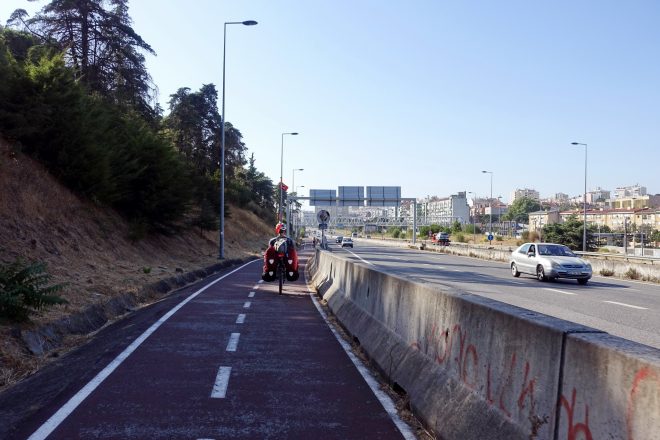
From the South: by ferry from Barreiro
This is the shortest way when coming from Setúbal, where you’d probably arrive by ferry from Tróia if you cycle up the Alentejo coast (a nicer and much longer way would be to go by Costa da Caparica, see “getting out” below). From Setúbal, we cycled North towards the neighbourhood of São Julião and then all straight until Baixa de Palmela. There, we took a left turn onto a small, unpaved road – and suddenly felt in the middle of nowhere: dense vegetation all around, quiet and not a car. The bad surprise came a bit later in the form of a very steep uphill (we had to push one bike at a time) to join the asphalted road leading into Palmela. The alternative is the busy main road on the other side of the hill – not a good choice either. From Palmela we took the main road east for a couple of kilometres, then took a right turn to cross diagonally towards Barreiro, taking several small roads between the fields. It was not exactly a picturesque route, but there are a few curiosities along the way – we won’t give them all away because you should go and see for yourself, but it included crossing a private golf resort where you must register at the entrance and exit. We were happy to have our GPS leading us through the neighbourhoods around Barreiro and to the ferry terminal, as the streets seemed a bit confusing. From there, a ferry goes to Terreiro do Paço at least twice and hour. We then followed the same way as described above to get to our final destination.
From the Northwest: from Mafra
This is the most direct way if you’re cycling down the coast and want to avoid the busy region around Sintra and Cascais (which we already knew). We left the coast and the busy main road just north of Ericeira, climbing over a hill and down the other side towards Santo Isidoro. From there it was another uphill that brought us to Mafra, known for its baroque palace that is worth visiting (there’s also a very good pasteleria opposite the palace).
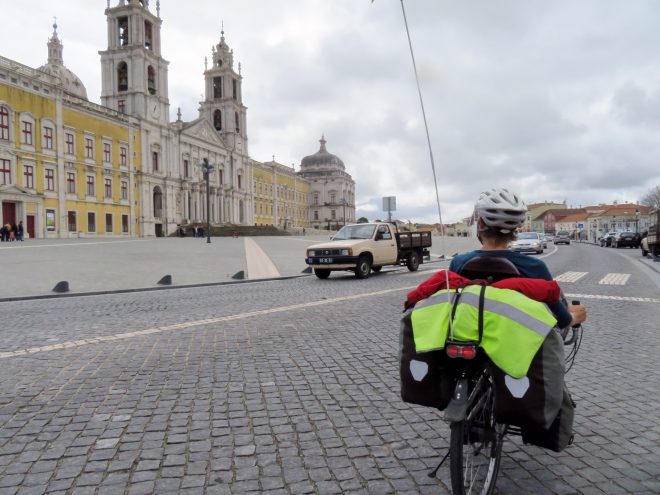
From Mafra we followed the busy main road for a short while (there was a cycle path on the left side of the road, but there was no indication of how to get there, so we ended up cycling on the main road’s side lane). On top of the hill, in Carapinheira, we turned right and followed a series of smaller roads through the countryside to the Southeast.
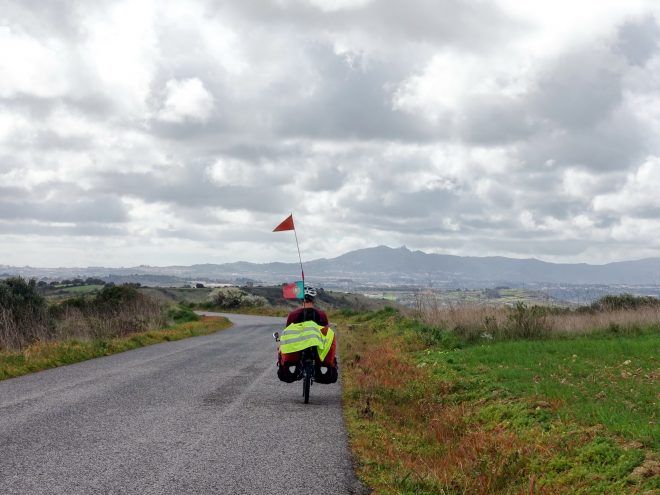
After a short stop at a picnic site in Caneças, it was a fast downhill along a busy but rideable road towards Encosta do Sol, where we were headed. From there, it is easy to join Pontinha and the cycle path going into the centre of Lisbon.
Getting out
To the South: by ferry from Belém
This was a great way out of Lisbon and towards the south to Setúbal. You could do this as a short trip (one to three days) out of Lisbon in combination with the route described above (“Getting in” from the South), or coming back by train from Setúbal.
Your way to the small ferry terminal in Belém will depend on where you’re based in Lisbon. For us, the easiest way was around the West of the hill of Monsanto. If you’re coming from the centre, you’d probably take the cycle path along the Tejo from Cais do Sodré.
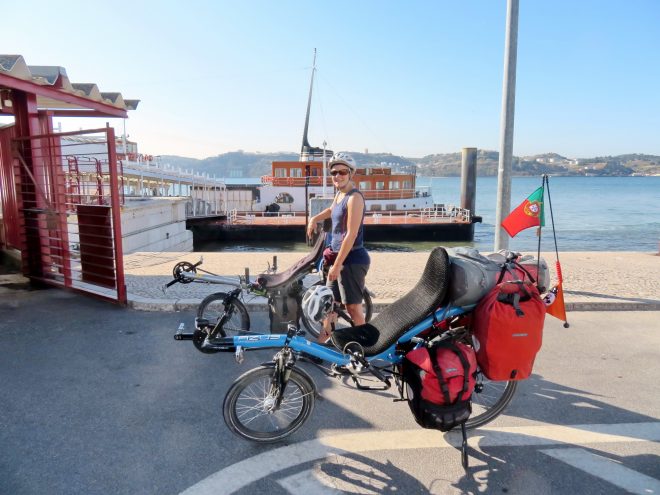
The ferry to Trafaria runs about once an hour – check the timetables before you go. It’s a big ferry and taking bikes is not a problem. From Trafaria there’s a cycle path going to Costa da Caparica, from where you can follow the road along the beaches (and stop for a swim in one of them).
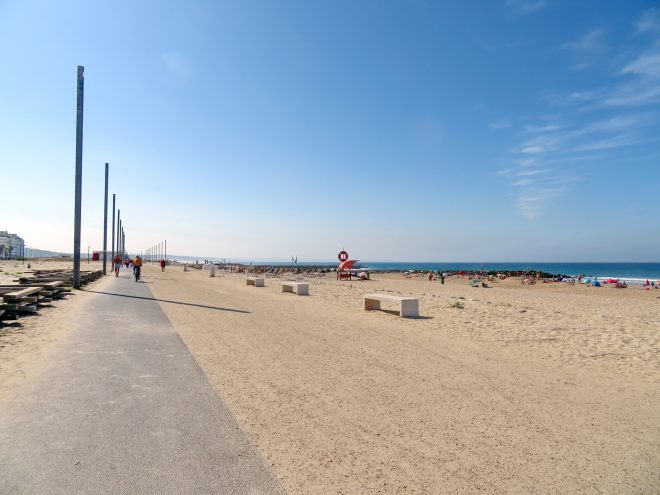
At the end of the road, there is a mountain bike trail that crosses the forest (Mata da Apostiça), but when we were there in September it was very sandy and not doable with loaded touring bikes (and even very difficult for mountain bikers). We therefore had to take the detour on the road, but managed to cut a bit across the forest on a nice path that one of the mountain bikers showed us (take a right turn at the roundabout with a BP gas station – you have to cross a gate to get on the trail). We then joined the busy road again to get to Apostiça, and continued on mostly smaller roads towards the Serra da Arrábida, trying to avoid too much up-and-down in the process (this is a very hilly region). We reached Setúbal on the road following the coast.
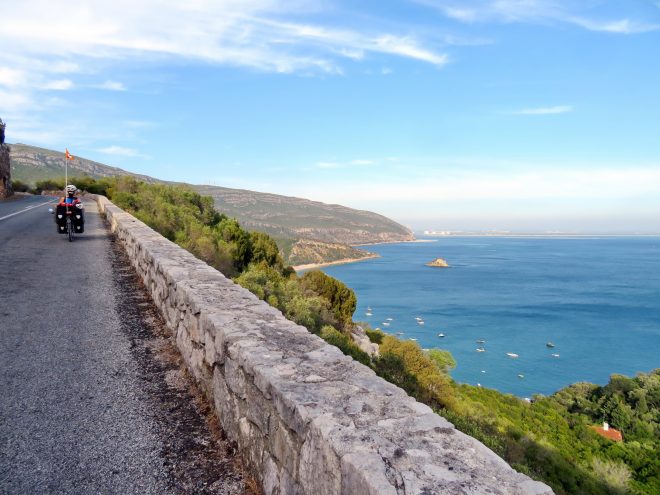
To the Northeast: along the Tejo to Vila Franca de Xira
We took this way out on our route to Elvas. It was a bit of a hit and miss, because the area along the Tejo is quite industrial and has busy roads. But we didn’t want to take the ferry to Montijo another time, so we gave it a try. Importantly, we cycled this route on a Sunday – on a weekday I would expect a lot more trucks on the road.
From our base in the Northwest of Lisbon, we took the cycle path towards Lumiar and then some smaller roads to get around the airport and into Sacavém. If coming from the centre, you could reach Sacavém by taking the cycle path along the river to Parque das Nações.
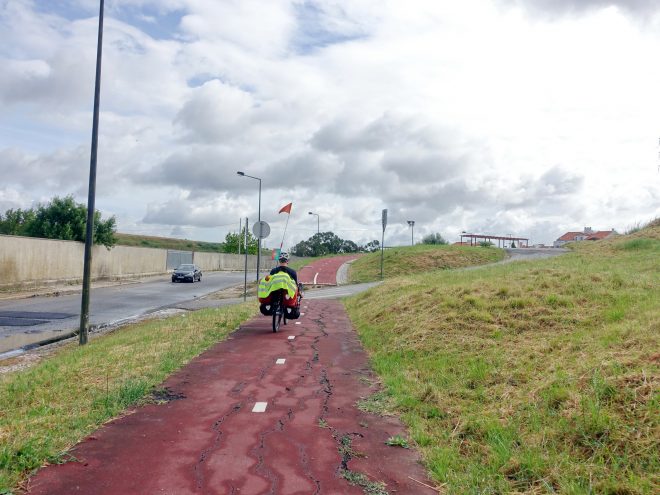
From Sacavém, we followed the pilgrims’ footpath to Fátima (or the Camino de Santiago – they are the same here), turning left after the bridge crossing the Rio Trancão. It’s an unpaved path with some rough bits, but we could cycle all along (although after heavy rain it might be less nice). In any case it was a good alternative to the main road.
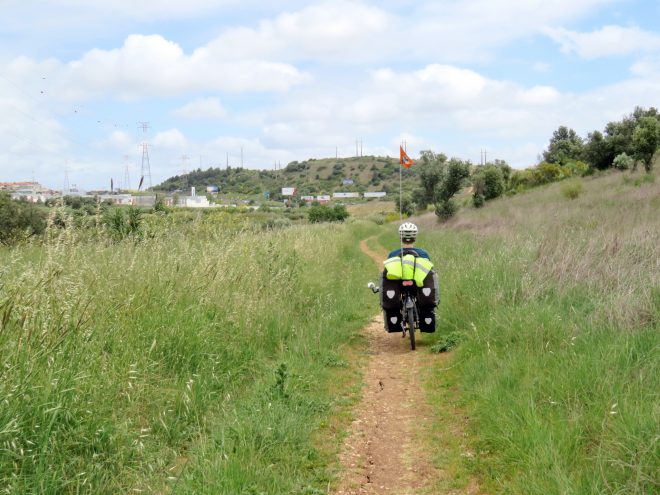
We returned to the main road in Póvoa de Santa Iría because it wasn’t too busy and because it was much faster than the dirt track. In Vila Franca de Xira we crossed the bridge over the Tejo. In principle, you can cycle on the sidewalk (that’s what people usually seem to do), but most of the access was blocked with concrete blocks and it was impossible to get on the sidewalk with our pannier-loaded bikes. We therefore cycled with the cars, which was not nice (there’s no space on the side) but ok, given that there were no trucks. On the other side, we took the first turn to the left between the fields to avoid the main road, which was busy, to continue our way East towards Coruche.
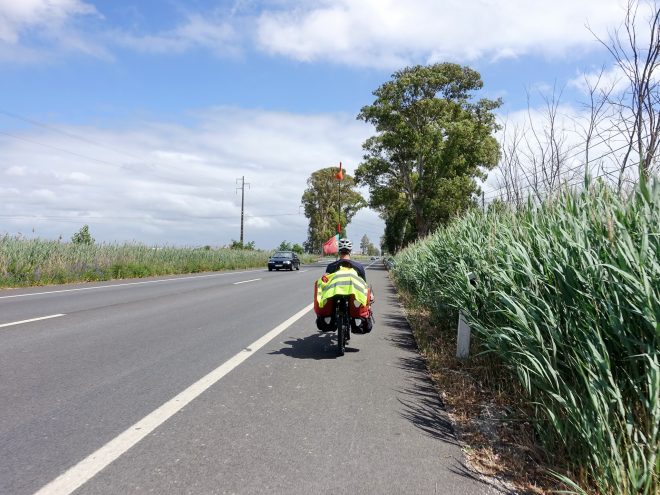
Have you cycled in and out of Lisbon?
Do you have a preferred route? Share it with us in the comments section below!






















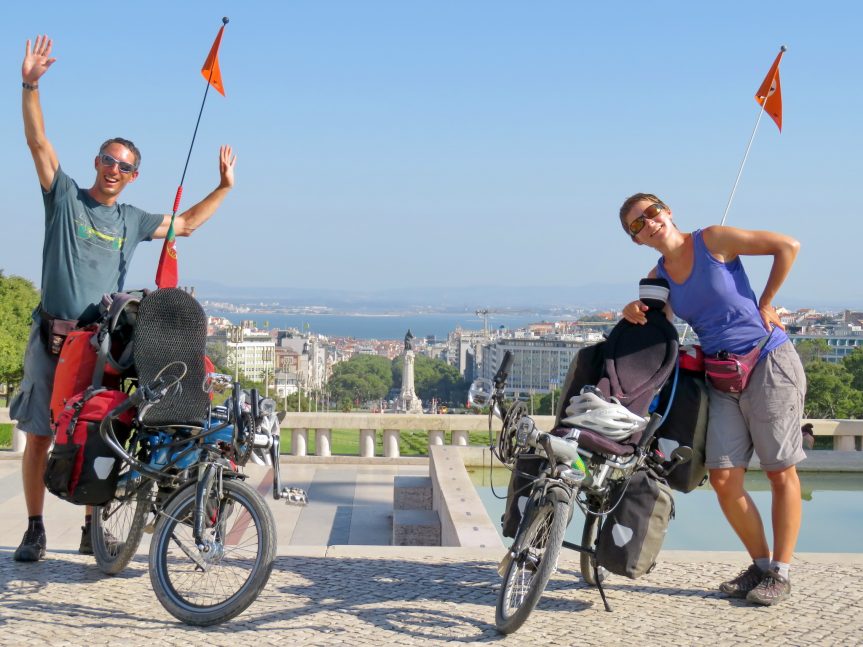
One thought on “Tips & tricks: How we got in and out of Lisbon by bicycle”